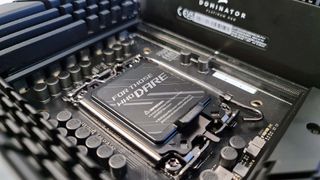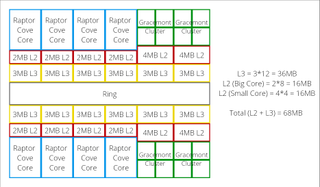13th Gen Raptor Lake CPUs could feature significant cache size increases
Intel to add big chunks of L2 cache.

It isn't easy for a company to release faster CPUs year after year. But there are two relatively easier ways to go about it. They can increase clock speeds or add more cache. Intel has put a lot of effort into its clock speeds while AMD's focus is on increasing cache. The latter is best illustrated by its claim of a 15% performance gain from its upcoming 5800X3D CPU, simply by adding more L3 cache.

Best CPU for gaming: the top chips from Intel and AMD
Best graphics card: your perfect pixel-pusher awaits
Best SSD for gaming: get into the game ahead of the rest
Intel’s cache sizes haven't seen anywhere near as large of a jump in recent years. But that could be set to change with its upcoming 13th Gen Raptor Lake CPUs, though its increases are to come from adding L2 cache rather than L3.
In a initial tweet, (via HotHardware) leaker OneRaichu stated that "68M cache is interesting.😄" OneRaichu later clarified that he was talking about the total amount of cache packed in to Intel's 13th Generation Raptor Lake CPU.
The cache structure of Alder Lake gets a bit confusing. The full Alder Lake die includes 1.25MB of L2 cache for each of the eight P cores. The two E-core clusters get 2MB of L2 for a total of 14MB of L2 cache. The L2 cache is joined by up to 30MB (3MB per P core and E core cluster) of shared L3 cache which gives a total of 44MB.
According to the rumors, Intel will increase the total amount of available cache from 44MB to 68MB. First we need to bear in mind that Intel is expected to increase the E core count from 8 to 16 which would mean a total of 54MB of L2 and L3 if Raptor Lake kept the Alder Lake cache structure.
To help visualize this potentially confusing bunch of numbers, another twitter user Olrak29_ made up a picture to illustrate what the cache structure of a hypothetical i9 13900K could look like.

If the leaks are accurate, Raptor Lake’s L2 cache sizes will increase from 1.25 MB to 2MB for each P core and 2MB to 4MB for each E core cluster. This would mean a total of 32MB of L2 cache for all cores and 36MB L3 cache for all cores. This delivers the grand total number of 68MB.
The biggest gaming news, reviews and hardware deals
Keep up to date with the most important stories and the best deals, as picked by the PC Gamer team.
It remains to be seen just how the extra L2 cache will affect performance. The L2 cache mightn’t look all that big but it offers a lot more bandwidth with lower latency compared to L3. If software is coded to take full advantage, there could be a significant IPC bump. That's something that games will take advantage of.
Of course we’ve hardly gotten over the launch of 12th Gen, and we’re still many months away from the release of 13th Gen Raptor Lake. We can't wait for the leaks to start. It will be interesting to see how Raptor Lake and Zen 4 processors differ in their cache structures, and what it means for gaming performance.

Chris' gaming experiences go back to the mid-nineties when he conned his parents into buying an 'educational PC' that was conveniently overpowered to play Doom and Tie Fighter. He developed a love of extreme overclocking that destroyed his savings despite the cheaper hardware on offer via his job at a PC store. To afford more LN2 he began moonlighting as a reviewer for VR-Zone before jumping the fence to work for MSI Australia. Since then, he's gone back to journalism, enthusiastically reviewing the latest and greatest components for PC & Tech Authority, PC Powerplay and currently Australian Personal Computer magazine and PC Gamer. Chris still puts far too many hours into Borderlands 3, always striving to become a more efficient killer.
Most Popular






